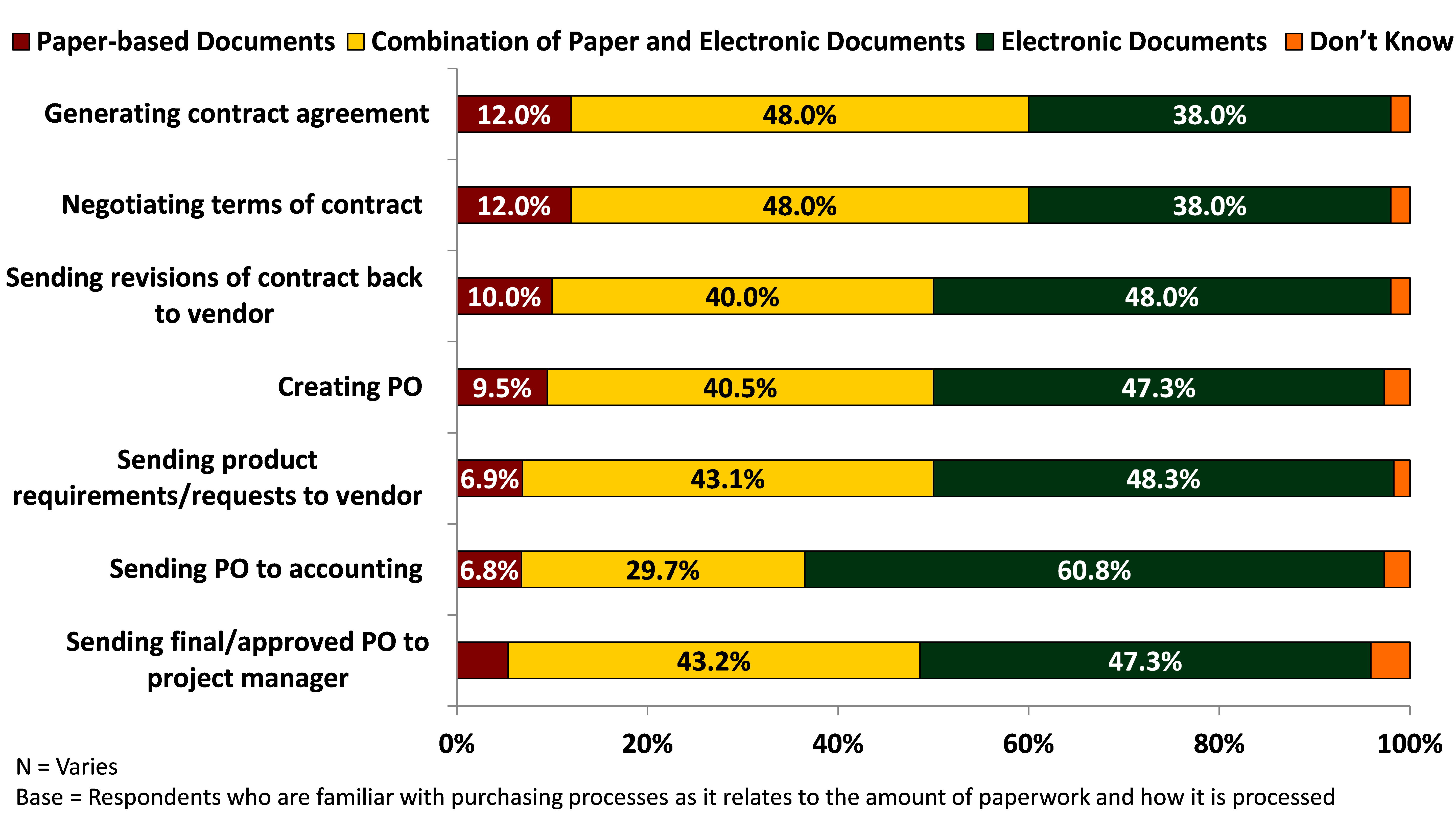When considering which accounting-related workflows need improvement, it’s important to not overlook those tied to purchasing. This insight piece will discuss common workflows within purchasing, and offer suggestions for optimizing these processes.
Why reviewing purchasing workflows matters
Before considering purchasing workflows within one’s organization, it may be helpful to understand why reviewing these processes is valuable. Keypoint Intelligence-InfoTrends research shows that many companies are still using manual and/or paper-based processes for various elements of purchasing.
For instance, only 38% are using only electronic documents for generating a contract agreement. With manual, paper-based activities often slowing down tasks, there’s clearly room for digitizing more operations. Input from staff as well as clients on long-standing processes may reinforce the need for newer technology.
Figure 1: For the most part, what is used to perform the following types of processes?

Source: Keypoint Intelligence-InfoTrends survey of U.S. businesses on accounting practices
Typical purchasing workflows
As part of a purchasing process review, stakeholders are encouraged to speak with colleagues who understand these processes the best. Oftentimes, this means employees that carry out these tasks on a daily or weekly basis. Sometimes, these processes may be detailed in an official policy book.
Organizations may wonder how their current purchasing processes compare to typical workflows in this arena. Keypoint Intelligence-InfoTrends has mapped out this information through interviews with employees involved with purchasing across companies.
The research shows that typically a project or inventory manager sends product requirements or requests to a vendor. The vendor’s legal or accounting department then sends contract terms and payment conditions to the project manager. The project manager’s internal legal and accounting departments then review the contract agreement for approval. If any changes or edits are needed, the contract is sent back to the vendor.
Once the contract agreement is approved, the vendor sends pricing for the goods and/or services to the project manager. A purchase order is created based on the pricing, and sent to the accounting department for approval. Accounting then sends the approved purchase order back to the project manager. Organizations are encouraged to consider how their purchasing processes may differ from this assessment, and which elements may slow down the overall purchasing process.
Table 1: Common components to purchasing
| Component | Documents | Internal stakeholders | External stakeholders |
| Project initiated | Proposals, requests for proposals (RFPs) | Project manager | Vendor |
| Contract agreement & terms | Contracts, legal agreements | Project manager | Vendor’s accounting department, vendor’s legal department |
| Contract approval | Contracts | Project manager, legal, finance director | – |
| Pricing of goods | Price quotations, tender documents | Project manager | Vendor |
| Purchase order generated | Purchase orders (POs) |
Project manager, accounting |
– |
Opportunities for automation
There are various ways businesses can improve upon the purchasing process. For instance, within an accounting or document management system they can create templates for requests for proposals (RFPs) and requesting estimates. These templates can incorporate corporate branding as well as other key pieces of business information; not needing to add these elements repeatedly can really cut down on the time needed to prepare documents.
Another timesaver is the automatic routing of received estimates and proposals into a document management system as well as to the appropriate managers for discussion and approval. Not only does this help improve productivity, but automation based on preset configurations can help guarantee that no documents or stakeholders are overlooked.
Another opportunity for process improvement is the automatic creation of a purchase order upon approval of a proposal and/or estimate. Similarly, electronic copies of the purchase order can be automatically routed to the appropriate managers (e.g., a project manager, inventory manager, and accounting manager). Other automation features may also be part of the document management platform, such as automatic backup of purchasing information on the company server or in the cloud.
Summary
Many organizations are still using manual, paper-based processes as part of their purchasing operations. As these tend to slow down the steps involved with purchasing, it may make sense to consider automating some of these processes through new software and cloud-based services. Each company is advised to consider its purchasing workflows in most need of improvement, and seek input from their business technology provider(s) on potential solutions. Contact Precision today and let us help you select the right solution.
